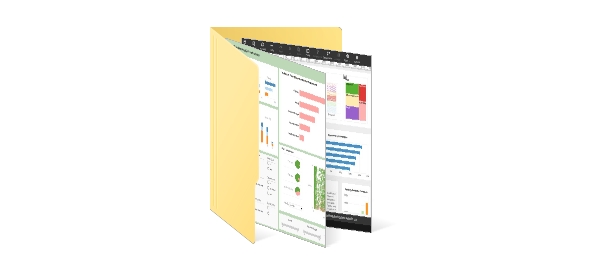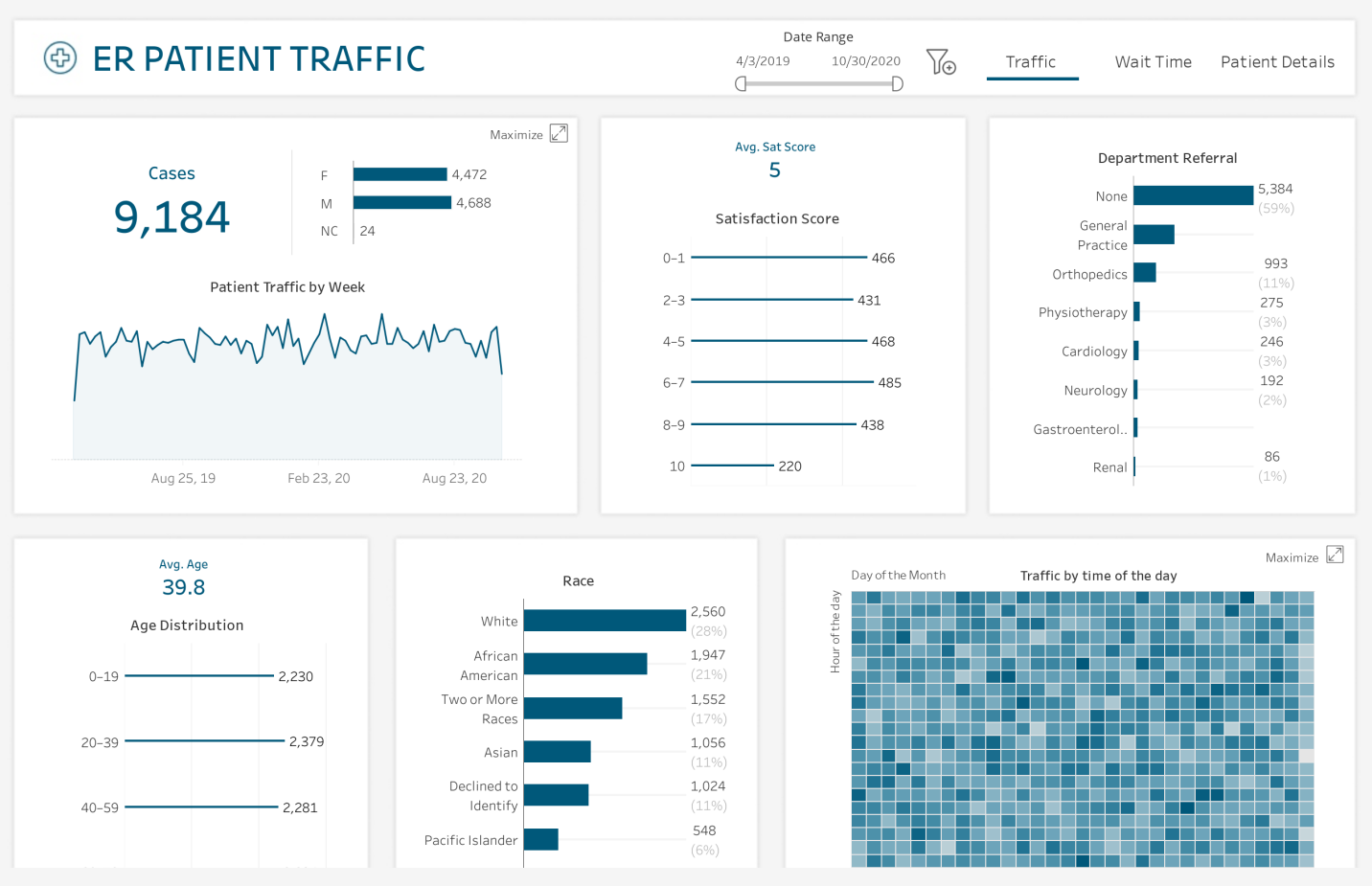What KPIs and Analytics Are Used on Emergency Room Dashboards?
Dashboards in emergency rooms are vital instruments for keeping an eye on and controlling many facets of patient care and operations. Analytics and Key Performance Indicators (KPIs) are essential to achieving this.
We will dive into the realm of emergency room dashboards in this post, examining the important KPIs and statistics used as well as their importance in improving efficiency and patient outcomes.
| #1 Ranking: Read how InetSoft was rated #1 for user adoption in G2's user survey-based index | Read More |
Overview of Dashboards in Emergency Rooms
Emergency room dashboards are all-inclusive visual displays that provide up-to-date information on a variety of operational factors. For the purpose of observing, evaluating, and improving patient care and operations, they are essential resources for healthcare administrators, physicians, and employees. In order to accomplish these goals, these dashboards' utilization of KPIs and analytics is essential.
1. Patient Throughput Metrics:
Effective patient flow is a vital component of emergency room operations. Various KPIs and analytics are used by ER dashboards to monitor and improve patient flow. These consist of:
Door-to-Provider Time
The amount of time it takes for a patient to see a doctor after arriving at the emergency room is called the "door-to-provider time." This KPI aids in evaluating how well early evaluations and triage are done.
Length of Stay (LOS)
One important statistic that shows how long a patient stays in the emergency room (ER) from admission to release or transfer is the duration of stay. It helps with resource allocation optimization and the identification of patient flow bottlenecks.
Left Without Being Seen (LWBS) Rate
The proportion of people who leave the emergency room without seeing a doctor is measured by the LWBS rate. Extended wait times or inefficiencies in the triage procedure might be indicated by a high LWBS rate.
2. Resource Utilization Metrics:
An emergency room must use its resources effectively in order to run efficiently and provide high-quality treatment. KPIs and analytics are used into ER dashboards to track resource allocation and utilization:
Staffing Levels
Making ensuring the emergency room (ER) has enough staff to manage the present patient load is made easier by using real-time staffing analysis. Physician coverage and nurse-to-patient ratios are two KPIs in this area.
Bed Occupancy Rate
The proportion of ER beds that are occupied at any one moment is measured by the bed occupancy rate. In order to maximize bed turnover and guarantee that beds are available when required, this statistic is essential.
Equipment Availability
For the sake of patients, it is essential to monitor the availability of vital medical supplies and equipment. Analytics that provide light on inventory control and equipment use may be seen on ER dashboards.
 |
Learn about the top 10 features of embedded business intelligence. |
3. Quality of Care Metrics:
Any emergency room's main objective is to provide the best possible treatment. KPIs and analytics are used to assess and improve the quality of care given:
Patient Satisfaction Scores
Scores on patient satisfaction provide insightful commentary on the quality of service and patient experience. For continuous development, patient survey data and comments may be shown on ER dashboards.
Adverse Events and Complications
Healthcare professionals may pinpoint areas where patient care may need to be improved by keeping track of adverse occurrences and consequences. This include keeping an eye on drug mistakes, infections, and other patient safety concerns.
Mortality Rates
Examining the death rates in the emergency room (ER) may reveal trends and opportunities for better patient treatment. It's critical to recognize the difference between unexpected death from avoidable causes and anticipated death.
 |
Learn the advantages of InetSoft's small footprint BI platform. |
4. Financial and Operational Metrics:
Any healthcare facility's capacity to remain viable depends on its ability to handle money and operations effectively. KPIs and analytics are combined in ER dashboards for this reason:
Revenue Cycle Metrics
Keeping an eye on revenue cycle data, such days of accounts receivable and average reimbursement per patient, aids emergency rooms in staying financially stable and streamlining billing procedures.
Wait Times
The length of time patients must wait for certain ER treatments, including lab work or diagnostic imaging, is crucial to both patient satisfaction and business productivity. Data on wait times may be seen in real time on ER dashboards.
Resource Allocation
Allocating resources as effectively as possible while maintaining high standards of care entails making sure that personnel and equipment are employed. Analytics may assist in identifying places where resources can be misused or overallocated.
 |
View the gallery of examples of dashboards and visualizations. |
5. Public Health and Epidemiological Metrics:
When a disease epidemic or public health emergency arises, ERs are often the first to respond. KPIs and analytics may be included into dashboards to monitor and address certain scenarios:
Disease Surveillance
Emergency rooms (ERs) may spot possible outbreaks and take appropriate action by keeping an eye on patterns in patients who come with certain symptoms or diagnoses. Monitoring the occurrence of infectious illnesses is part of this.
Emergency Preparedness
It is critical to evaluate the ER's preparedness for crises and catastrophes. Analytics are a useful tool for assessing resource availability and the ability to manage spikes in patient traffic during emergencies.
6. Regulatory Compliance Metrics:
Many rules and guidelines must be followed by ERs in order to guarantee patient safety and high-quality treatment. KPIs and analytics are available on ER dashboards to track compliance:
Documentation Compliance
It is crucial to make sure that paperwork and patient records adhere to legal requirements. Measures pertaining to the accuracy and completeness of patient records may be included in ER dashboards.
Reporting Requirements
Regulatory bodies often ask ERs to disclose particular occurrences and data. Dashboards may help in keeping track of and fulfilling these reporting requirements.
 |
Learn how InetSoft's data intelligence technology is central to delivering efficient business intelligence. |
7. Patient Severity and Acuity Metrics:
Prioritizing treatment and distributing resources efficiently depend on having a thorough understanding of the severity and intensity of patients' diseases. KPIs and analytics are used by ER dashboards to determine patient complexity:
Triage Scores
Patients are categorized according to the severity of their conditions using triage ratings, such as the Emergency Severity Index (ESI) or the Canadian Triage and Acuity Scale (CTAS). These ratings are shown on dashboards to guarantee that high-acuity patients get prompt treatment and that resources are allocated appropriately.
Case Mix Index (CMI)
The total complexity of patient cases handled in the emergency room is evaluated using the CMI measure. It considers the kinds and gravity of diagnoses, which might affect the use of resources and payment.
8. Diagnostic and Laboratory Metrics:
Timely findings and effective diagnostic tests are essential in the emergency room. Dashboards use analytics and KPIs to track and improve diagnostic procedures:
Turnaround Time (TAT) for Lab Tests and Imaging
TAT calculates how long it takes to finish and submit diagnostic imaging and laboratory test findings. TAT may be tracked by ER dashboards to guarantee that crucial tests are completed on time.
Diagnostic Yield
The proportion of tests that result in a conclusive diagnosis is measured to determine the diagnostic yield, which evaluates the efficacy of diagnostic procedures. More accurate testing is indicated by a larger diagnostic yield.
 |
View the gallery of examples of dashboards and visualizations. |
9. Medication Management Metrics:
Medication administration in the emergency room has to be precise and secure. Analytics and KPIs pertaining to drug administration are essential:
Medication Error Rate
Medication administration safety concerns may be found by keeping an eye on prescription mistake rates. Data about the quantity and kinds of mistakes may be seen on dashboards.
Adherence to Medication Protocols
Analyzing compliance with evidence-based pharmaceutical guidelines guarantees that patients get suitable and efficient care, which enhances results.
10. Patient Flow Forecasting:
Predictive analytics may be integrated into ER dashboards to estimate patient loads and maximize resource allocation during peak times:
Predictive Patient Arrivals
Predictive analytics can determine how many patients are anticipated to visit the ER in the near future based on past data as well as current information. Planning for manpower and resources is aided by this.
Capacity Planning
ERs may use predictive analytics to assist them figure out how many beds, employees, and other resources they'll need to handle expected patient loads.



